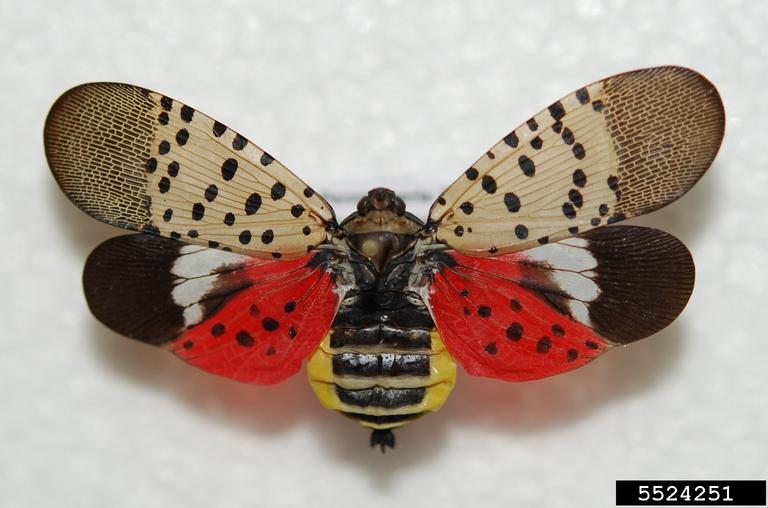Spotted Lanternfly: What It Is and What to Do
The Spotted Lanternfly is a newly arrived invasive species that has been confirmed in Camden County, and it's population is rapidly growing. They have the potential to do severe damage to our trees, crops, and other plants.
The Spotted Lanternfly

The adult form, usually seen in summer or fall
Young Juvenile
Older Juvenile, late spring
Spotted lanternflies feed on branches and tree trunks, and so that is where they are often found. Though they appear to have varied appetites, they are particularly attracted to Tree of Heaven (Ailanthus altissima), an invasive plant that "typically grows in clumps in sunny areas along highways or disturbed habitats such as the edges of crop fields, open spaces, or parks." (Credit: Rutgers' New Jersey Agricultural Experiment Station) Its other preferred hosts include black walnut trees, red maples, grapes, hops, apples, and peaches. Because of this, the lanternfly is a great threat to New Jersey's natural spaces and habitats, as well as vineyards and farms that grow hops, apples, and peaches.
If you see a Spotted Lanternfly:
Take a picture
Kill it if you can
Report it to the State via the lanternfly hotline, 1-833-223-2840 (BADBUG0), or send the location and photo to SLF-plantindustry@ag.nj.gov and slanternfly@njaes.rutgers.edu.
If you see a Spotted Lanternfly egg mass:

Spotted lanternfly eggs look kind of like a spot of mud. You can find them in all kinds of settings during the winter or early spring, especially on tree bark, and you should take the very little time needed to get rid of them. The eggs can survive over the winter, and a single mass could hold up to 30 to 50 eggs that will hatch when spring arrives.
Scrape it off of the surface where you found it and put it in a baggy with rubbing alcohol or hand sanitizer.
Alternatively, use a hard item to thoroughly crush the egg mass, making sure to pop each of the eggs contained in it.
Look for others in the immediate area (it's usually not one isolated mass).
Lanternflies and Tree of Heaven:
Invasive Tree of Heaven
The invasive lanternfly seems to have a special relationship with Tree-of-Heaven (Ailanthus altissima). This invasive plant, purposely introduced to the United States in 1784, is accelerating the lanternfly's spread. This Penn State Extension article provides a thorough overview of their relationship: Tree-of-heaven and the Spotted Lanternfly: Two Invasive Species to Watch
Maybe the arrival of lanternflies can motivate us to pay greater attention to this tree, which is a nuisance in its own right. If you have Tree-of-Heaven on your property, now is a great time to remove it. Please note though, it is very easy to confuse Tree-of-Heaven with native Staghorn Sumac - make sure you confirm what you're dealing with before acting.
Unfortunately, Tree-of-Heaven is a very difficult tree to control due to its vigorous root system and suckering abilities, and most guides you'll find will recommend herbicide use. It is possible though, to defeat them by other means. If you have small seedlings, pull them by hand before they get too big and start forming their tap root. If you have larger trees, cut them repeatedly and frequently. The best time to cut them back is late spring through summer. This Maryland Dept. of Natural Resources Guide gives more thorough instructions on this approach.
This whole spotted lanternfly issue does have a bit of a horror movie vibe to it. It's also an excellent example of how much damage invasives can do, and the importance of the work we're all doing together to plant and support natives, and restore the ecological diversity of our region.



